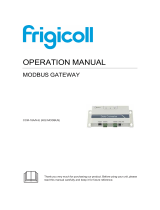
Table of Contents
1. Introduction ...................................................................................................................................... 1-1
Overview ........................................................................................................................................... 1-2
Package Checklist ............................................................................................................................... 1-2
Product Features ................................................................................................................................ 1-2
2. Hardware .......................................................................................................................................... 2-1
Power Input and Relay Output Pinouts................................................................................................... 2-2
LED Indicators .................................................................................................................................... 2-2
Panel Layouts ..................................................................................................................................... 2-3
Dimensions ........................................................................................................................................ 2-4
Pin Assignments ................................................................................................................................. 2-4
Mounting the Unit ............................................................................................................................... 2-5
Wall or Cabinet Mounting ............................................................................................................. 2-5
Reset Button ...................................................................................................................................... 2-5
Pull-high, Pull-low, and Terminator for RS-485 ....................................................................................... 2-6
3. Getting Started.................................................................................................................................. 3-1
Connecting the Power ......................................................................................................................... 3-2
Connecting Serial Devices .................................................................................................................... 3-2
Connecting to a Network ..................................................................................................................... 3-2
Installing DSU Software ....................................................................................................................... 3-2
Logging in to the Web Console ............................................................................................................. 3-3
4. Web Console Configuration and Troubleshooting .............................................................................. 4-1
Overview ........................................................................................................................................... 4-2
Basic Settings .................................................................................................................................... 4-2
Network Settings ................................................................................................................................ 4-3
Serial Settings .................................................................................................................................... 4-3
Protocol Settings ................................................................................................................................ 4-4
Protocol Settings—Protocol Conversion .......................................................................................... 4-4
Protocol Settings—Configure MGate’s Role 1 and Role 2 ................................................................... 4-5
Protocol Settings—I/O Data Mapping ........................................................................................... 4-15
System Management ......................................................................................................................... 4-16
System Management—Accessible IP List....................................................................................... 4-16
System Management—System Log Settings .................................................................................. 4-17
System Management—Auto Warning Settings ............................................................................... 4-18
System Management—Email Alert ............................................................................................... 4-18
System Management—SNMP Trap ............................................................................................... 4-19
System Management—SNMP Agent ............................................................................................. 4-19
System Management—LLDP Settings ........................................................................................... 4-20
System Management—Certificate ................................................................................................ 4-20
System Management—Misc. Settings ........................................................................................... 4-22
System Management—Maintenance ............................................................................................. 4-24
System Monitoring (Troubleshooting) .................................................................................................. 4-26
5. Configuration (Text Mode Console) ................................................................................................... 5-1
6. Network Management Tool (MXstudio) ............................................................................................. 6-1
MXview ............................................................................................................................................. 6-2
MXconfig ........................................................................................................................................... 6-2
7. Modbus Configuration Import/Export ............................................................................................... 7-1
A. SNMP Agents with MIB II and RS-232-Like Groups ........................................................................... A-1
RFC1213 MIB-II Supported SNMP Variable ............................................................................................. A-2
RFC1317 RS-232-Like Groups .............................................................................................................. A-3





















